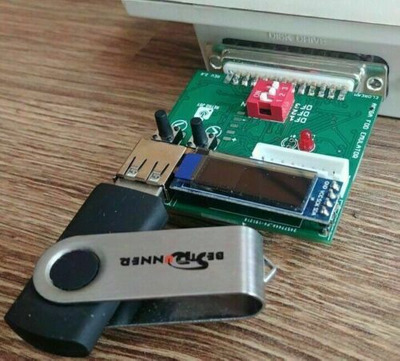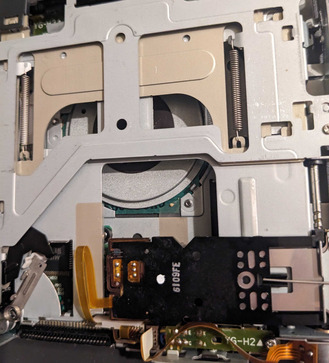Tough to say, what errors do you get when trying to use the drive?
Does it make a normal-sounding head-seek when the computer starts?
Something that's pretty common on these direct drive floppies that have sat for a long time is that the head stepper motor can jam, so you could see if you can turn the worm gear. Make sure it hasn't popped out of the carrier/bushing at the other end of the stepper motor shaft. I recommend putting a tiny little bit of lubricant into the stepper motor being careful not to get that on anything else. Putting a tiny amount of oil on the shaft that the heads move along could probably help.
Look at the inside of the drive's top cover as well, it should have a teflon pad stuck to the inside. See if that has any rips since I've discovered that can cause problems too, no idea how you fix that apart from replace the drive. I tried repairing my Toshiba Sateliite 2800-500's D353G drive and got it working but as soon as I put the top cover on it stopped working again since there were rips in that teflon causing the head to get stuck.
To test the drive out you really need a tool like IMD: http://dunfield.classiccmp.org/img/index.htm
- It's used in DOS and you press Esc on starting to get to the real menu though it doesn't hurt to read the documentation that shows first
- Insert a known good floppy disk either a new one or one that was formatted on a known good drive that has no trouble reading/writing
- First test out the RPM with 't' and press Enter to start the test, it should detect a 500K DD disk and 300RPM. Let it run for a bit to stabilise
- If that's okay, go into the alignment tool with 'a'. Press Enter to start and it'll start reading whatever it can identify from
- Press 0 to move the head to track 0 and see that it reads as being on track 0. It should look like this:
The "36 0" at the end indicating that 36 sectors are read and none not-read.
- Press 7 to step the head to track 70 and the head should read from track 70. The number being read will go down briefly until the disc has turned fully but it should stabilise after that.
- Press 'h' to switch which head you're reading from, that should also read "36 0" if it's good
- Press 'r' to recalibrate the head position, this moves the head back to track 0 then back up again
- Press 0 to move the head back from 70 to track 0
- Go back to 7 and see if it's okay on Track 70, then press '+' to step the head one track at a time. Go up to track 79, the last track on a 3.5" DS-HD
- At this point if that all worked, I like pressing 'r' a few times to have the head seek from 79 to 0 and back again, that has freed up the head on a direct drive floppy that I was testing the other day that was having trouble reading things
If you see the drive shows numbers less than 36 on a regular basis, or the drive can't detect what type of disk is inserted, there might be some bigger problem with the drive. Although I use the IMD alignment tool for testing drives, actually aligning the drive with track 0 and aligning heads is something I really recommend against doing anything with initially. At that point it's worth considering the cost of a replacement drive if they can be found easily.
I hope that helps for you but if not then we can see what else can be done. I've got another D353G drive that I bought that I was refunded for because it just didn't respond to anything as far I could tell, like mechanically it was all good but didn't seem to do anything. It's been used for parts so I can't do further testing on that drive, but if yours is similar it would be interesting to see at what point it fails with ImageDisk

